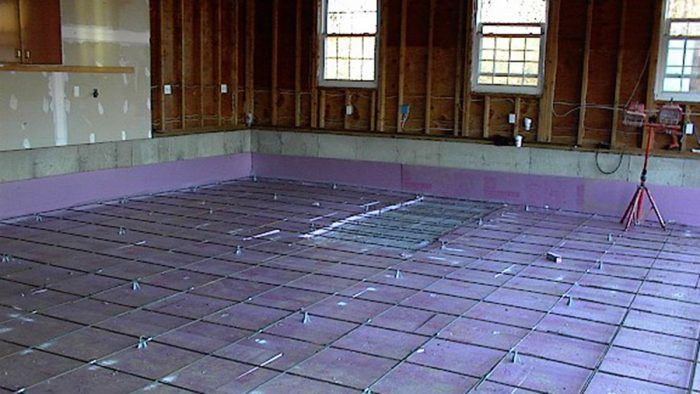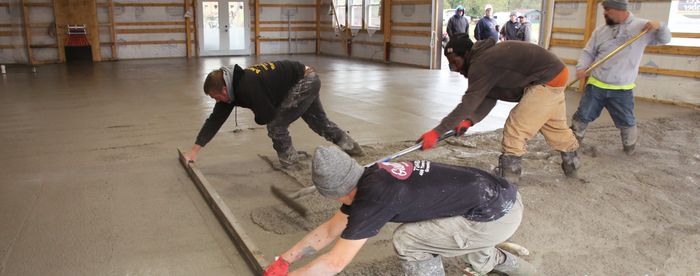How to Pour a Rock-Solid, Well-Insulated Garage Slab
A homeowner turns to the Fine Homebuilding community forum for advice on building an extra-strong concrete floor for a garage workshop.

Greggo is building a garage, not your run-of-the mill garage for the family cars and a lawnmower but a three-bay structure that can handle a 7,500-lb. truck and a five-ton car lift.
Here’s the plan: Use a 4,000-lb. psi mix 5 in. thick in two of the bays, and up that to 6 in. to 7 in. in the third day where the car lift will be located. He’s also adding #3 rebar 18-in. on center as well as fiber mesh in the concrete.
The garage is being built over a sand base, he says in this post to the Fine Homebuilding construction forum, but he has a few questions.
Would it be a good idea to add 2 in. of rigid foam insulation beneath the slab even if he doesn’t add radiant-floor heat? Should the rebar be pinned to the sidewalls? And should he replace the sand base with 3/4-in. stone?
“I live in CT,” he says. “Any help will be appreciated.”
First, get rid of the sand
“I would never, ever place concrete over sand, even with a vapor barrier under it,” says davidmeiland. “I would remove the sand and place at least one 4-6 in. lift of washed 3/4-in. gravel down, more if possible. Compact and level it. That gives you a reasonably good capillary break so that ground moisture can’t so easily migrate up thru your slab prep and into the slab itself.”
The key is getting the right mix of crushed rock, he says, a product without a lot of fines (grit) in it that would hold moisture. That’s the problem with sand.
Meiland would follow that with Stego Wrap or Tu-Tuf, or a similar product, tape the seams and all penetrations, then lay down extruded polystyrene (XPS) foam rated at 25 psi, such as Foamular 250 (manufactured by Owens Corning). Rebar should be elevated by 1 1/2 in. before the concrete is poured.
“I always order a low-water mix with a plasticizer, less water in the batch is a lot better IMO,” he writes. “If you need bearing locations for the lift, you could cut out small areas of the foam where the lift will sit, but that’s probably not necessary, and if you really want to know you will need an engineer to look at the loads and the slab performance.”
Connecting slab and aprons
Tying rebar in the slab to sidewalls may not be necessary, or even advisable, but at least one post suggests that connecting the main floor slab to the aprons at door entrances is a good idea.
“Pinning the apron to the slab is just doweling some #4 rebar into the garage slab at each door,” writes Dave Richeson. “[It’s] generally done after the larger slab is poured and the forms wrecked. (BTW I like to thicken the slab at the door openings).
“I have installed dowels through the door form boards and stubbed them into the apron area but it is a real PITA to wreck forms if done that way.
“The pins from the garage slab into the apron slab reduce the risk of the apron lab pulling away or moving up or down.”
But don’t worry too much about the strength of the concrete under the car lift, says clewless1. The manufacturer’s call for 4 in. of concrete had seemed skimpy to greggo, which is why he had considered placing as much as 7 in. of concrete in that bay.
“Concrete at 3,000 psi distributed across a metal plate say 8×8 gives you a lot of capacity when you think about it,” clewless writes. “Also, if in doubt, simply cut away the insulation around your mounting area and thicken the slab …standard detail for column support in the center of a slab.”
Insulating the slab
Using rigid foam insulation around the perimeter of the slab to minimize heat loss seems like an obvious step, but whether to place insulation under the slab is another story. That decision may hinge on whether the slab is heated, but there’s no agreement on what building codes require, if anything.
“Are you planning to heat the garage now or eventually?
Then insulating under the slab is not the way to go,” writes manhattan42. “The foundation walls should be insulated instead, either outside or inside, from the sill plate to the top of the footing or frost depth whichever comes first. Otherwise you will lose energy through the edge of the slab and any masonry exposed above grade.”
Not so, says davidmeiland. “Energy code around here requires R-10 under the slab unless the building is unheated,” he says. “You are correct in pointing out that the foundation walls should be insulated as well. Here that would be R-10 inside the walls to a depth of 24 in. or more.”
But manhattan42 insists: “Underslab insulation is not required under most energy codes(like the IECC) and in fact is prohibited from being used instead of foundation insulation by such codes,” he writes. “Of course, there may be some local variations of these national requirements.
“Generally speaking, however, the only place underslab insulation is required is when the slab itself is heated.
Otherwise the majority of heat loss is through the upper portions of the building, not through the soil or slab, and adding insulation under the slab provides only added cost while offering little or no energy savings benefit at all.”
And clewless1’s retort? “The slab and ground beneath are unlimited heat sinks that will draw energy out of your heated space. In radiant slabs, the slab temperature is much higher and it makes most sense to insulate because of that. But insulation should benefit either condition…albeit maybe fairly small in the unheated slab condition…but to imply it provides NO benefit and is in fact PROHIBITED by an energy code is IMO incorrect.”
An expert opinion
We asked Peter Yost, technical director at GreenBuildingAdvisor, for his thoughts. Here’s what he had to say:
First, absolutely nuke the sand layer and go with free-draining 3/4-inch, no-fines gravel as a capillary break.
Second, use XPS insulation. It is non-porous, so it can act as a capillary break as well.
Finally, ground-coupled heat flow is really complex so figuring out the heat loss difference between a shallow frost-protected foundation and sub slab insulation is hard, BUT if any sort of is going into the slab, definitely insulate under and around the perimeter of the slab, decoupling the slab entirely from the ground.
Fine Homebuilding Recommended Products
Fine Homebuilding receives a commission for items purchased through links on this site, including Amazon Associates and other affiliate advertising programs.

Reliable Crimp Connectors

Handy Heat Gun

8067 All-Weather Flashing Tape






View Comments
I live in florida...the state is a sand-bar........the moisture break is the visqueen or plastic............
What will that building be doing in twenty years?
It's a heck of a lot easier and cheaper to insulate under the slab now!
Not having the insulated slab "sweating" with seasonal changes is enough reason for me.
I always follow Mr. Yosts recommendations when building in the north.
If the interior is climate protected, the IECC codes require a level of insulation based on climate zone, see IRC R402.1.2/N1102.1.2 (commercial go to IBC). The table is attached herein. Values for zones 1, 2, & 3 are all ZERO, and then it jumps to R10. If the interior is not climate protected (freezes in the winter), frost protection of the slab is required by ICC codes. Some times the use of a free floating slab is chosen and frost protection ignored, but movement should be anticipated. FHA shallow frost protected design allows 12" frost non susceptible fill over adequate insulation on the interior to count as frost protected, and is accepted in it's updated (details are a bit different) current form: ASCE 32. See the link below for the original (free) document.
Below the slab, material is generally called out as a coarse *well-graded* stone which ideally has some sands. The best material is not washed crushed stone unless you have filter fabric and can't be sand unless the slab is more than 5" thick due to subgrade modulus trouble. The best material is something like the structural fills called out by the state and federal DOT/HWY manuals. They are expensive blends of croase well-graded aggregate with some coarse to medium sands but very little fines. Refer to CT DOT M.02.05 for a reference material, link below and image attached. All is frost resistant as a primary restriction, while being high enough in stone to provide stable support for a flexible pavement such as 4" lightly reinforced concrete slabs. Frost non-susceptible fill is ≤6% passing the 200 sieve, so crushed stone counts, but putting washed crushed stone on fine material is a problem. Use of any material over or next to a finer material must be considered against fines migration. The general rule is that the 85th percent grain size particles (D85) of the finer material should be less than 4 times smaller than the 15th percent particles (D15) of the coarser material so that the fine particles don't wash into the voids of the coarse material. In other words, fine sand mixed with 15% 1/8" gravel will be able to not wash into 1/2" stone but will wash into 3/4" stone. If you put washed crushed 3/4" stone down without knowing if the soil below it is going to be able to work into the stone and be frost susceptible, you should be putting down filter fabric, foam or something else between the two to stop the migration.
I doubt the required thermal break is acheived between the exterior apron and the main building if it is pinned with steel.
https://www.huduser.gov/publications/pdf/fpsfguide.pdf
https://portal.ct.gov/DOT/CONNDOT/SECTION-M02